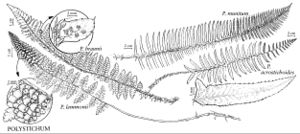Polystichum acrostichoides
Gen. Fil. plate 9. 1834.
Stems erect. Leaves dimorphic (only in this species); fertile pinnae distal, much contracted; sterile leaves arching, 3–8 dm; bulblets absent. Petiole 1/4–1/3 length of leaf, densely scaly; scales light-brown, diminishing in size distally. Blade linear-lanceolate, 1-pinnate; base narrowed. Pinnae oblong to falcate, not overlapping, in 1 plane, 2–6 cm; base oblique, acroscopic auricles well developed; margins serrulate-spiny with teeth ascending; apex acute or blunt with subapical and apical teeth same size; microscales filiform, lacking projections, dense, on abaxial surface only. Sori confluent, completely covering abaxial surface of pinnae (only in this species); indusia entire. Spores light-brown. 2n = 82.
Habitat: Forest floor and shady, rocky slopes
Elevation: 0–1500 m
Distribution

N.B., N.S., Ont., P.E.I., Que., Ala., Ark., Conn., Del., D.C., Fla., Ga., Ill., Ind., Iowa, Kans., Ky., La., Maine, Md., Mass., Mich., Minn., Miss., Mo., Nebr., N.H., N.J., N.Y., N.C., Ohio, Okla., Pa., R.I., S.C., Tenn., Tex., Vt., Va., W.Va., Wis., Mexico, naturalized in Europe
Discussion
Polystichum acrostichoides is a common species most closely related to P. munitum (G. Yatskievych et al. 1988), which also occurs extensively on forest floors.
The dimorphic pinnae of Polystichum acrostichoides are not unique to the genus; they are found also in some Asian species. Numerous variants have been named, mostly as forms, but none are of taxonomic consequence. Hybrids are known with P. braunii (P. × potteri Barrington) and P. lonchitis (P. × hagenahii Cody). The latter hybrid is rare, known only from its type locality in Ontario, where it grows with both parents. It is recognized by its intermediate morphology (leaves wider than P. lonchitis, narrower than P. acrostichoides, with slightly contracted sorus-bearing pinnae) and malformed sporangia and spores. Polystichum × potteri is much more widespread, from Nova Scotia, New Brunswick, and Quebec through New England to Pennsylvania. It resembles P. braunii but has narrower leaves bearing malformed sporangia.
Selected References
None.
Lower Taxa
"dm" is not declared as a valid unit of measurement for this property."/4lengthofleaf" is not declared as a valid unit of measurement for this property.
